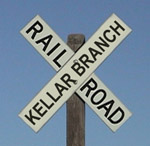Within the Land Development Code (LDC) there are four “form districts.” Those districts are the Sheridan/Loucks Triangle, the West Main Corridor, the Prospect Road Corridor, and the Warehouse District. These four areas underwent intense study and a customized form-based code was created for each district. Each area is essentially pre-planned by citizens through the charrette process and codified by the city’s consultants, Farrell Madden Associates.
Last night the City Council adopted the form-based codes for the four form districts (this includes the regulating plan and illustrative plan for each).
However, the LDC code for the rest of the Heart of Peoria Plan Area outside those form districts — i.e., the vast majority of the Heart of Peoria Plan Area — is not ready for prime time yet. The council tabled it until staff can make some revisions.
Here’s the issue. The portion of the LDC outside of the form districts (we’ll call this area a “base district” to distinguish it from a “form district”) was not subjected to the kind of intense study that the form districts were. The form districts are kind of like a new house — it’s a code built from scratch to the citizens’ specifications. The base district is like an old house with a little remodeling work done on it to bring it up to code — it’s basically our existing zoning ordinance with some modifications to make it more “new urbanist” (such as allowances for mixed use, urban setback regulations, etc.).
To continue the metaphor, the council wasn’t happy with the old house simply being brought up to code. They know we can’t afford to develop full-fledged form-based codes in all 8,000 acres of the Heart of Peoria Plan area, but they nevertheless felt the base districts did not go far enough. Specifically, the base district regulations don’t address the problems that are hindering reinvestment in older neighborhoods.
Gary Sandberg gives a good example. If you want to build a garage, the code says you can build one that is similar to other garages in your neighborhood. There’s a reason for this: you want to have some amount of consistency in your neighborhood. If everyone on your block has detached garages with alley access, you don’t want one house to have an attached garage with street access — it would be totally out of character for the neighborhood.
The problem is, you may live in a neighborhood where they used to have garages, but almost all of them have been razed, so now there are essentially no garages. Then what? Can you not have a garage? Or what if all the garages in your part of town are one-stall, and you want a two-stall garage? Are we going to make people build a one-stall garage or have to get variance to built a two-stall? The danger is that if there are too many hoops to jump through — if there are too many places for the City to tell people “no” — it discourages reinvestment.
There are also some potential conflicts with existing ordinances. Sandberg (who apparently has all city ordinances memorized) pointed out that the street ordinance prohibits private development within 100 feet of the centerline of a thoroughfare, yet the LDC allows (and in some cases requires) infill commercial development be built right up to the sidewalk. That needs to be reconciled.
I’m worried that the LDC is going to languish. It was not the intent of the council to have it languish, but we have to face reality. A major revision of the city’s comprehensive plan is coming up, and that’s the next big project on which Planning & Growth is going to focus. There’s no budget left for our consultants to revise the LDC. So staff is going to have to do the work, but when? Some council members believe staff should be able to do both. I don’t know enough about how they’re organized or what their work load is to make that determination.
But I do know that it would be a real shame and an excuse for further cynicism about local government if the LDC were left on the table too long or, worse, forgotten. Somehow this needs to stay on the front burner and get done soon before it loses momentum.

 In the never-ending Kellar Branch saga, there’s a legal battle going on before the Surface Transportation Board (STB).
In the never-ending Kellar Branch saga, there’s a legal battle going on before the Surface Transportation Board (STB).